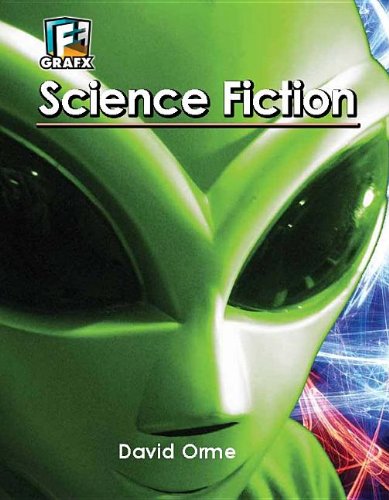-
Podkayne of Mars
Robert A. Heinlein
Mass Market Paperback (Ace Books, June 28, 2005)While accompanying their uncle, a wily politician, on a trip from Mars to Earth, Podkayne and her brilliant, but pesky brother are caught in a plot to keep Uncle Tom from an important conference. Reprint.
-
Thinking Machines
Isaac Asimov, Martin Harry Greenberg, Charles G. Waugh, Bruce Bond
Library Binding (Heinemann/Raintree, Sept. 1, 1981)Stories suggest some unexpected results of using computers and robots in insurance, transportation, and sales S
S
-
Comets
Helen Orme, David Orme
Paperback (Perfection Learning, July 1, 2009)Millions of years ago, a giant meteorite killed all the dinosaurs. Find out how! Will humans all be killed in the same way? Find out what we can do. Is there life on the planet Mars? Scientists think maybe the answer is yes. Find out why. Get the facts. Got that? Then read a scary story about what might happen: "Doom from Space". Finally use the Word Check to make sure you know your comets from your asteroids! Q
Q
-
The Courts of Chaos
Roger Zelazny
Paperback (Sphere, March 15, 1988)Corwin finds his world dissolving around him when his father Oberon, disguised as Corwin's friend, steals the Jewel of Judgment so that he may defeat the evil Brand, in a conclusion to the first Amber series. Reissue.
-
Great Disasters
Helen Orme, David Orme
Hardcover (Perfection Learning, July 1, 2009)What is a disaster? Is being ill a disaster? Or 75 million people dying in the Black Death? That sounds like a disaster! Find out what kinds of things make disasters happen. Oh, and if disasters are bad - what about mega-disasters? They're a lot worse. Find out here. Then read the story The Eruption. Who can you trust when a volcano erupts near you? This is one of a series on books on popular non-fiction topics. As with other books in the series, a full colour non-fiction section is followed by a fiction story based upon the topic. The story appears in two formats: one with simple texts for poor or reluctant readers; the facing pages contain an illustrated "speech bubble" version for those who are just starting to read. W
W
-
After the End
Isaac Asimov, Martin Harry Greenberg, Charles G. Waugh, Paul Vaccarello
Library Binding (Heinemann/Raintree, Sept. 1, 1981)Four stories depict what the world might be like after a nuclear war L
L
-
Weird Places
Helen Orme, David Orme
Hardcover (Perfection Learning, July 1, 2009)From Death Valley to jungle temples where humans were sacrificed, from a giant lake under the ice to pirate treasure that nobody can reach. There are some weird places in the world. Find out all about them; get the facts. Got that? Then read "The Lost Tribe", a story about what might have happened to a race of tiny humans. Then use the Word Check to make sure you sound like an expert on the weirdest parts of the world. U
U
-
Sea Killers
Helen Orme, David Orme
Paperback (Perfection Learning, July 1, 2009)The sea is a dangerous place. There's sharks of course, but the real dangers are much smaller. Like a killer octopus the size of a golf ball. And it's not just animals: there are pirates, and giant waves that can break boats in two! Get the facts. Got that? Then read "Shark Attack!" -- a great diving sotry about what to do when a shark is after you and it can REALLY smell your blood! Finally, use the Word Check to make sure you know your tentacles from your tsunami. S
S
-
Great Journeys
Helen Orme, David Orme
Hardcover (Perfection Learning, July 1, 2009)Great Journeys looks at some of the greatest journeys ever made - starting with human beings' first great journey 150,000 years ago: leaving Africa. Find out who first discovered America, who reached the South Pole first (and who came second!). Then find out about the great journey to reach the Moon. The fiction story 'The Big Sleep' tells of a man who spends a hundred years asleep in space, on the greatest journey ever.The Trailblazers series has been written for older children and young adults with a reading age of 5-8. The books are suitable for general reading or as part of a more structured reading program. Each book is on a strong, popular topic, with a colorful, attractive layout. Each book has a non-fiction and a fiction section. The fiction story appears in two formats - one with simple texts for poor readers; the facing pages contain an illustrated "speech bubble" version of the same story, for those who are just starting to learn to read. These two levels of entry give access points for children and young adults with different reading ages. The vocabulary of each book is carefully limited, with simple sentences to reinforce reading skills, which make the books suitable for even the poorest readers. Y
Y
-
How to Be a Pop Star
David Orme
Hardcover (Perfection Learning, March 31, 2012)Where do you find a band? How do you get a gig? Learn the facts before reading a story about what happens when pride gets in the way of making great music.
-
Science Fiction
David Orme
Hardcover (Perfection Learning, March 31, 2012)Explore aliens, time travel, and more before reading "The City" and seeing how the future might not be a great place to live. N
N
-
Trumps of Doom
Roger Zelazny
Paperback (Avon, March 15, 1986)Sphere edition paperback vg++ 3rd print